US Envoy Proposes 'QUAD Satellite' Development in India-US Space Partnership

The US proposes a QUAD satellite collaboration with India, strengthening space cooperation with Japan and Australia. This initiative aims to enhance mutual capabilities and foster international partnerships in space technology and exploration.
US Ambassador to India, Eric Garcetti, has proposed the development of a "QUAD satellite" in partnership with India. This initiative aims to strengthen the cooperation between the two countries in the field of space exploration and technology.
During his official visit to Bengaluru, Garcetti met with S Somanath, the Chairman of the Indian Space Research Organisation (ISRO), at ISRO headquarters. They discussed ongoing collaborations and future prospects in space science and technology.
The proposal for the QUAD satellite is a significant step in the partnership between India and the US. The concept is expected to involve not just India and the US, but also Japan and Australia, the other members of the QUAD grouping, to enhance space collaboration among these nations.
ISRO stated that during the meeting, Chairman Somanath highlighted the potential for developing advanced detectors and packaging technologies through collaborations with US-India academic institutions. He also emphasized the importance of standardizing docking interfaces across human space programs to facilitate international cooperation on space platforms. Additionally, he discussed the possibility of developing a navigation system for the moon, either in orbit or on its surface.
In a social media post, Garcetti expressed his commitment to strengthening the US-India space partnership. He mentioned the ongoing collaboration on the NASA-ISRO Synthetic Aperture Radar (NISAR) satellite, human spaceflight initiatives, and commercial space endeavors as part of the US-India Initiative on Critical and Emerging Technology.
The discussions also covered other mutual interests and shared goals, such as the Artemis Accord, the use of the Laser Reflectometer Array on Chandrayaan-3, and ongoing associations through various Joint Working Groups. Garcetti inquired about the Department of Space's role in promoting commercial space activities. Somanath explained that for the first time, payload technology and space-bound hardware are being developed in Indian facilities outside of ISRO labs. ISRO plans to source payloads and satellites from Indian companies to help them enter the global market.
The meeting also touched upon NASA’s potential participation in India's proposed G-20 satellite for environmental and climate change monitoring. They discussed encouraging cooperation between commercial companies from both countries for faster and more effective outcomes. Additionally, they explored the Gaganyaan cargo module as an option for transferring cargo to the International Space Station (ISS).
Garcetti praised ISRO's achievements and its significant role in global space exploration. Future programs discussed included exchange visits of professionals from both sides, continuation of balloon experiments, and identifying milestones for collaborative projects.
The proposed QUAD satellite initiative and the continued collaboration between ISRO and NASA underscore the growing strategic partnership between India and the US in the space sector. This partnership is expected to contribute significantly to advancements in space technology and exploration, benefiting both nations and the broader international community.
The QUAD, or Quadrilateral Security Dialogue, is a strategic forum comprising the United States, India, Japan, and Australia. Initially formed to ensure a free and open Indo-Pacific, the QUAD has been expanding its focus to include cooperation in various fields, including space.
The NISAR mission, a joint project between NASA and ISRO, aims to measure changes in the Earth's ecosystems, ice mass, and crust. It is expected to provide critical data for understanding climate change, natural disasters, and other environmental phenomena.
The Artemis Accords are a set of principles for international cooperation in space exploration, led by NASA, to ensure peaceful and transparent activities on the moon, Mars, and beyond.
India’s Gaganyaan mission aims to send Indian astronauts into space, making India one of the few countries to have independent human spaceflight capabilities. The mission includes developing a cargo module for potential use with the ISS, showcasing India's growing capabilities in human spaceflight and international space collaboration.


